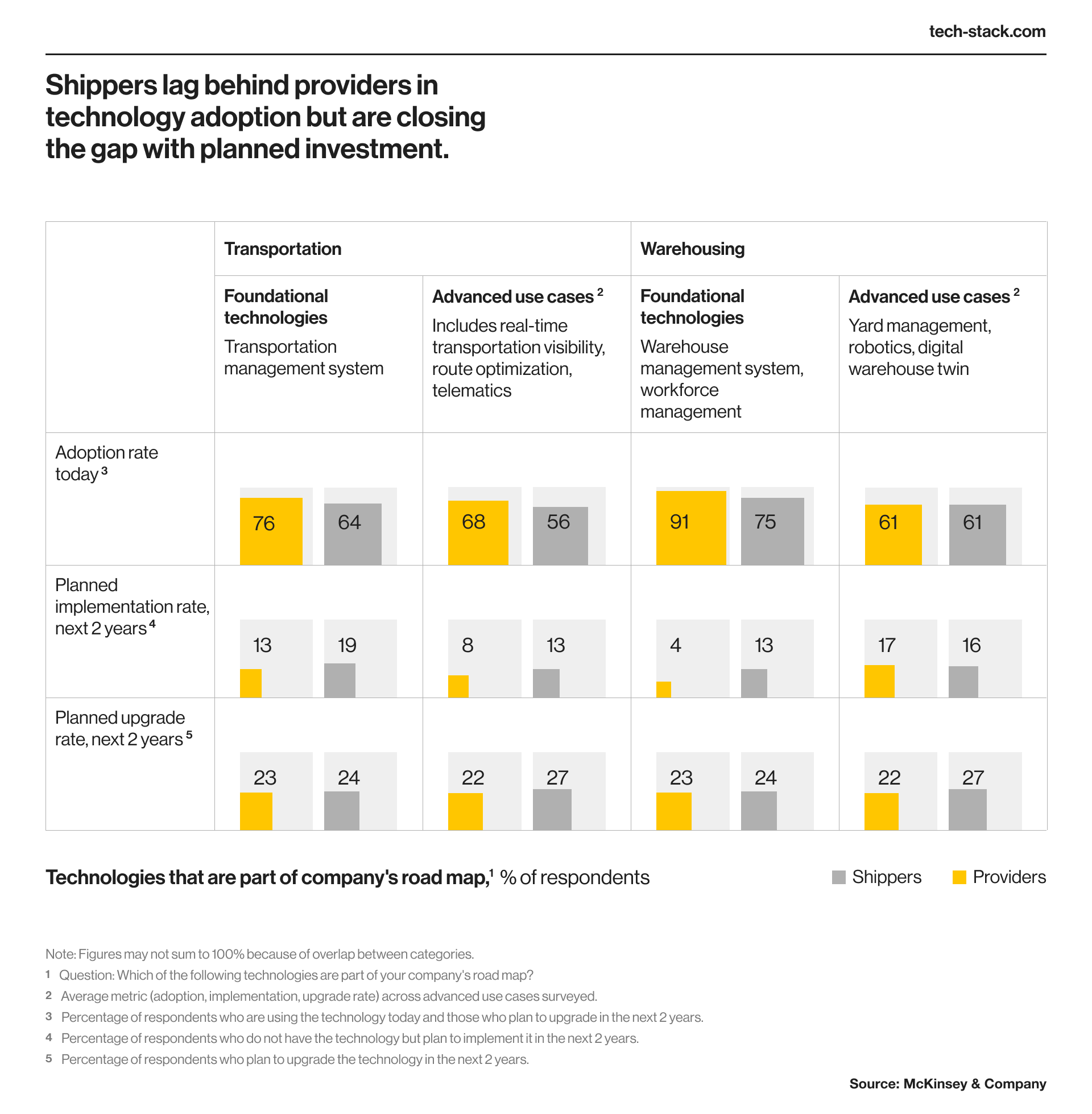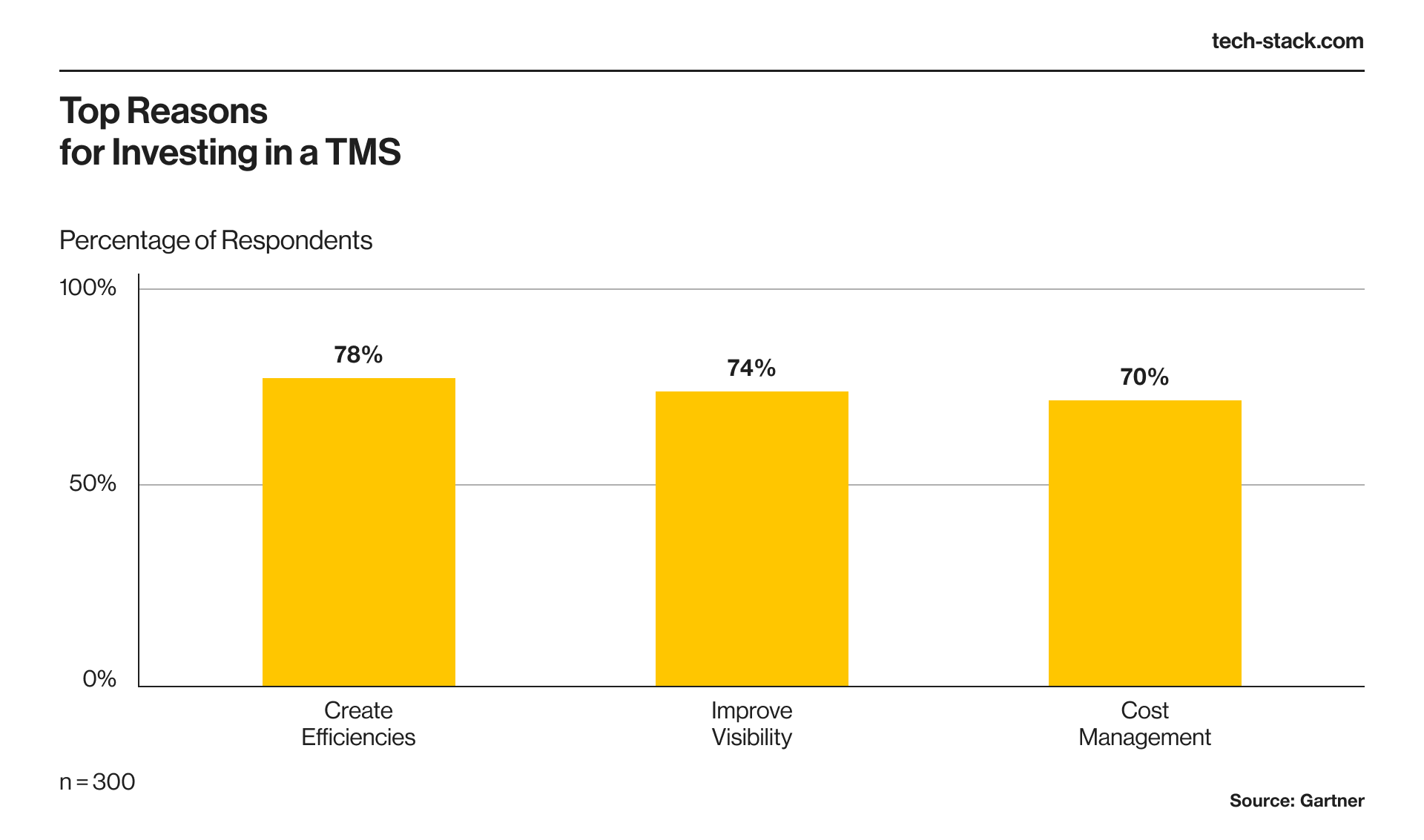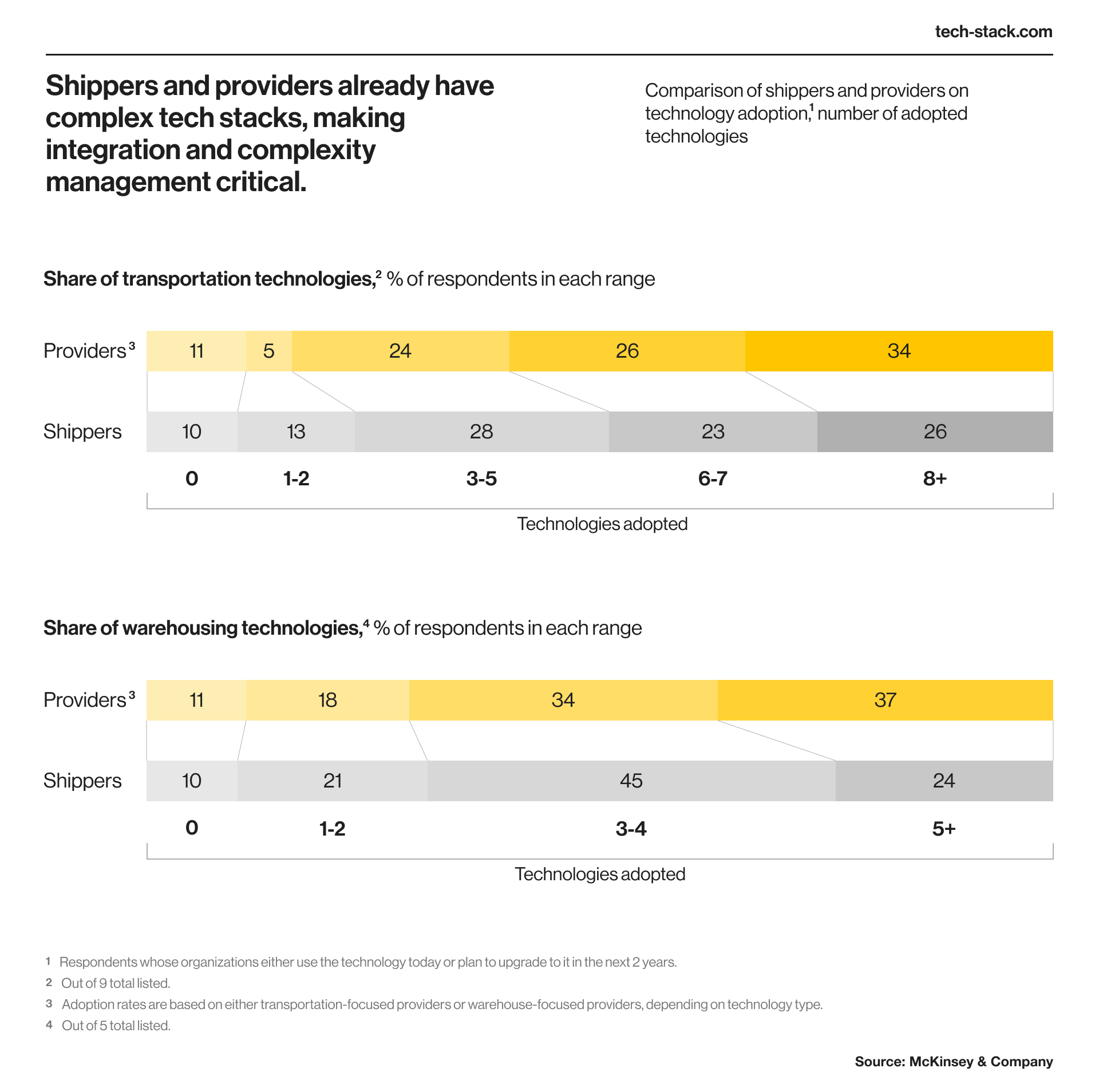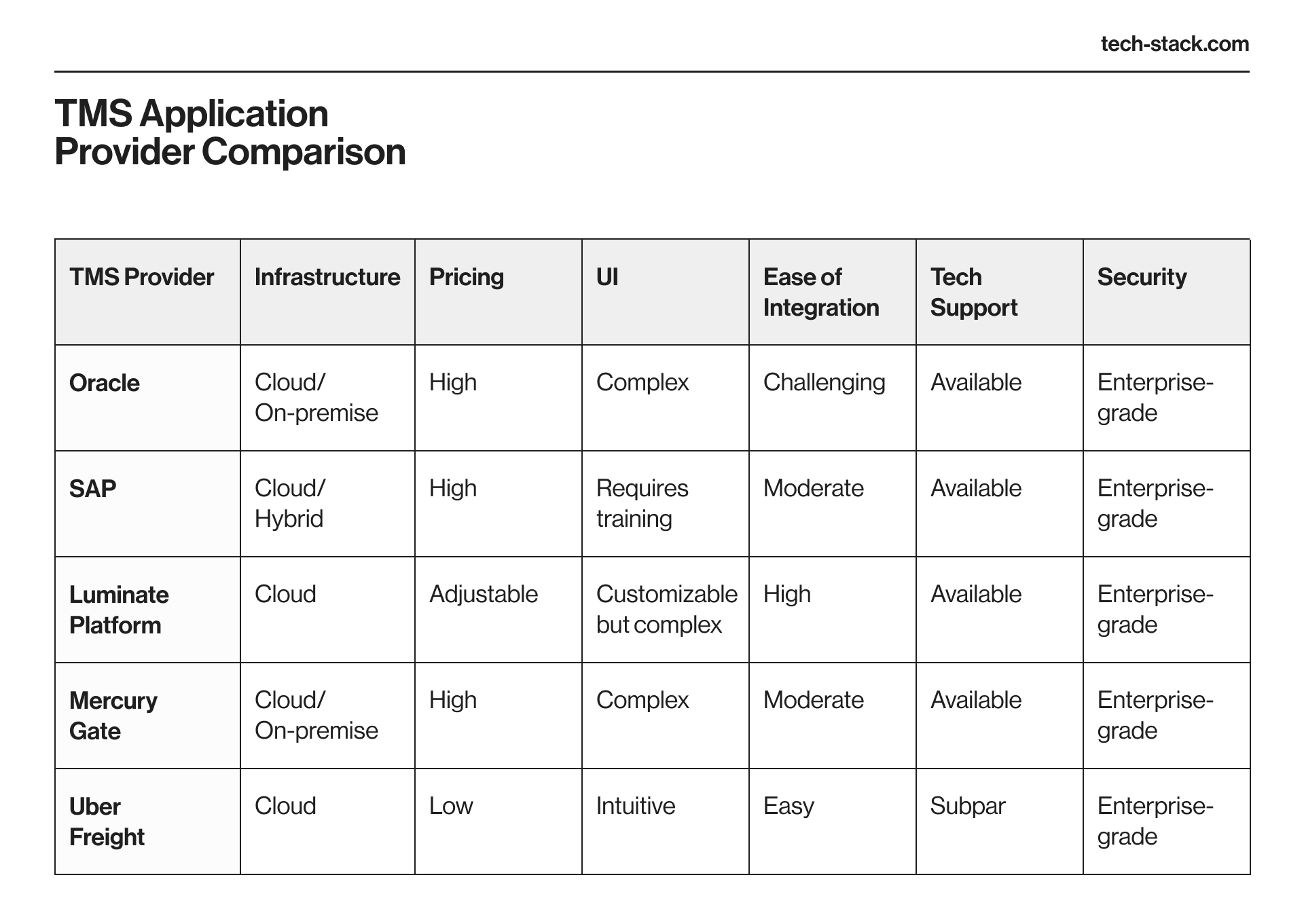Transportation management in logistics is now mainstream. Industry research predicts that the transportation management software market will grow from $5.8 billion in 2021 to over $14.4 billion by 2027. This high demand reflects the need for efficient transportation amidst global disruptions and expanding trade.
Managing logistics and shipping operations efficiently is nearly impossible without reliable transportation management system software. However, not all solutions are equal, and organizations with legacy tools often struggle to effectively coordinate freight movements, optimize routes, predict demand, and control costs.
This article provides help and guidance for those looking to implement or upgrade a transportation management system (TMS). We will explain the TMS's transformative role in a modern supply chain and highlight its key features and business advantages. Then, we will explore the key considerations when choosing a TMS provider.
Finally, we’ll guide you through the implementation process to ensure your system delivers the desired results.
How Logistics Businesses Benefit from Transportation Management Systems
A Transportation Management System (TMS) is a software tool set that simplifies the planning, tracking, and delivery of goods throughout the supply chain and across multiple regions, jurisdictions, and transport modes.
These systems are now essential tools in industries and businesses of all sizes. McKinsey’s 2023 Digital Logistics survey of over 250 global logistics providers and shippers shows that TMS solutions are now so mainstream that companies without them risk losing out to competitors.

To better understand the TMS boom, just consider these transportation management system benefits:
- Minimized fuel expenditure. Organizations can identify the fastest routes and optimize fuel consumption to boost overall profitability.
- Streamlined load management. A TMS can optimize load distribution to maximize carrying capacity and travel distances. Software with these kinds of features shortens delivery schedules and reduces unnecessary operational expenses.
- Data-driven logistics optimization. Software with machine learning capabilities and business analytics can predict potential demand and supply chain disruptions, allowing companies to align their operations more tightly with market demand.
- Smarter warehouse management. IoT sensors and RFID tags help track inventory items and supply chain assets, leading to better inventory placement, warehouse movement operations, and more efficient stock control.
- Reduced costs with predictive maintenance. Thanks to AI and machine learning, a TMS can analyze visual cues, sounds, and equipment sensors to anticipate maintenance needs. This lets companies schedule maintenance proactively, which prevents breakdowns and extends vehicle life.
- Environmental sustainability. Reduced travel distances and fuel consumption lead to lower carbon emissions and a smaller environmental footprint.
- Elevated customer experience. Real-time tracking and delivery updates make a transportation service feel more reliable for customers. This improvement in the service contributes to customer satisfaction, repeat business, and referrals.
- Real-time operational visibility. A 2023 Gartner survey reports that 74% of organizations invest in TMS to improve operational visibility, for example, with IoT-enabled real-time tracking and actionable insights. Greater visibility allows for swift decision-making and helps anticipate and address disruptions.

- Regulatory compliance. Automated document generation and regulatory checks allow organizations to produce accurate paperwork for delivery routes that span several jurisdictions, reducing the risk of violations.
In short, the right TMS software brings significant benefits ranging from operational efficiency and cost reduction to environmental sustainability. All these things contribute to your business growth. They also show the importance of selecting a system that meets your organizational needs.
What to Look for In Software for a Transport Management System
Your complete requirements for TMS software will be based on your transportation networks, processes, and regional units, but should generally include the following considerations.
Functionality
To begin with, what operating features should you look for? Gartner’s 2023 Magic Quadrant for Transportation Management Systems highlights the critical capabilities of the most effective systems. Here, we’ll focus on what we consider to be the core features of logistics, transportation, and shipping organizations.
- Freight sourcing (procurement management) allows businesses to compare freight options based on carriers' historical performance, routes, rates, and contract terms.
- Shipment rate management tools monitor and analyze changes in fuel prices, carrier rates, and market conditions to suggest the most economical shipping methods.
- Dock scheduling helps manage the allocation of trucks to loading docks at warehouses or distribution centers. You can schedule and track arrivals and departures to avoid dock congestion and shipment delays.
- Order planning streamlines order entry and tendering by automatically filling out details in documents for the corresponding orders. Many systems allow you to specify rules for tendering, so the TMS will automatically pick the best partners based on costs, load allocation, or end-customer preferences (based on previous shipments).
- Vehicle routing uses GPS and analytics data to determine the most efficient routes for delivery. It considers factors like road conditions, delivery priorities, and real-time traffic updates to reduce travel time. For example, truckers can consult the system to check for road closures.
- Transportation forecasting analyzes historical transportation data and current market trends to forecast future transportation needs. This insight helps you budget and strategize for high demand during specific dates, such as the holiday season.
- A settlement module handles invoicing, payments, and freight auditing processes in compliance with transportation-related regulations. This simplifies document management, financial settlements, bills of lading, and claims.
- Fleet management includes tools for managing fleet vehicle status, scheduling maintenance, and tracking fuel consumption. The software for IoT devices can provide insight into vehicle driving speed, break times, and the response time to real-time alerts. It may also monitor the environmental impact of logistic processes and enable remote transportation control systems.
- Performance management analytics uses AI and ML-powered algorithms to identify areas suitable for service improvement and cost savings based on KPIs (for example, based on on-time delivery rates, cost per delivery, and fuel consumption rates for different routes).
- An event management module can warn about real-time disruptions and unexpected deviations during delivery. One example is cold chain logistics tools that notify the driver about temperature or humidity changes in cargo with perishable products so the driver can prevent spoilage.
- Carrier communication tools provide secure, encrypted communications between managers, warehouse workers, carriers, and drivers. They facilitate coordination, real-time updates, and document sharing.
- 3D load modeling helps place the cargo in vehicles based on a virtual model. The automation feature can suggest the best placement to maximize space usage and ensure cargo safety.
These built-in features are not the only things to look out for—your TMS software must also work seamlessly with your existing systems and tools.
Integration capabilities
Modern logistics and shipping companies manage several TMS-related solutions. McKinsey research shows that 34% of transportation providers have more than eight technologies in their TM stack. Smooth integration is key to bringing all these data sources together.
Integration capabilities
Modern logistics and shipping companies manage several TMS-related solutions. McKinsey research shows that 34% of transportation providers have more than eight technologies in their TM stack. Smooth integration is key to bringing all these data sources together.

The lack of standards for data sharing between partners and vendors is a known problem among logistics and supply chain vendors. It's important to ensure that the solution converts data from other systems outside the TMS for seamless data sharing. That’s why, before committing to a TMS provider, you should check that the software integrates with your other business tools, such as:
- Enterprise Resource Planning (ERP): ERP systems should be able to integrate transportation and logistic data for more accurate resource planning and financial reporting.
- Warehouse Management System (WMS): Integrating a TMS with a WMS helps synchronize asset provisioning and inventory control to drive the efficiency of warehousing operations.
- Order Management System (OMS): OMS-TMS integration allows you to automatically capture, fulfill, and track orders across multiple eCommerce channels.
- Retail or eCommerce platform: In retail, integrating an eCommerce platform with a TMS aligns order processing and scheduling. This can allow customers to select an appropriate carrier or track their delivery.
- Business Intelligence (BI) software: The mass of TMS data should fuel your BI and data analytics software, helping you make more informed decisions and forecast trends.
- Third-Party Logistics (3PL) system: Integrating TMS with 3PL systems is essential for outsourced logistics operations, as it ensures seamless coordination during procurement and fulfillment activities.
Once you’ve checked that a TMS has the right features and integrates seamlessly with your systems, it’s time to think about your processing load.
Scalability
As your logistical activities grow, so does your data volume and system load. Your transportation management system needs to be able to handle new IoT devices and software integrations easily to maintain operational performance at peak times.
To ensure you have enough operational resources at any point in time, we recommend considering the following solutions:
- A cloud-based infrastructure: Modern solutions are primarily cloud-based subscription services that help you avoid extensive hardware installation, setup, and maintenance.
- Autoscaling: This capability allows resources in cloud applications to scale up and down based on demand, so you only pay for what you need.
- Modular architecture: TMS software built on a modular, loosely coupled architecture lets you add or modify features without disturbing existing processes.
- Mobile applications: Mobile versions ensure that all your employees, from managers to field personnel to drivers, stay connected to logistics operations.
To check that a TMS will reliably scale for you, we advise getting a free trial version from the provider and testing it under extreme conditions.
We developed an auction platform for cargo allocation and bidding that speeds up logistic operations by automatically validating the most cost-effective bids. The platform is built on scalable AWS infrastructure to ensure high performance under any load. We also designed web and mobile interfaces to allow employees to engage with the platform on the go.
After understanding what a good solution for transportation and logistics management is, you need to know how to implement it in your business operations.
How to Effectively Implement Transportation Management System Software
At Techstack, we work with both startups and enterprises. In each case, we follow a time-tested process of detailed business analysis, strategic planning, and test-driven integration. Here are the six steps you can take to ensure successful TMS integration.
1. Research your needs and opportunities
The first step is to carry out an in-depth analysis of your logistics, transportation, and supply chain needs. Review your existing processes and application portfolio to understand where your opportunities for streamlining and cost-cutting lie. Involve your employees, as their experience can provide invaluable insights.
Beyond an internal audit, analyze how your competitors use their transportation management systems. Their successes and shortcomings may inform your choice of a TMS provider.
2. Choose your TMS provider
Your research should give you specific criteria for selecting your TMS provider. As we’ve seen, the right solution will offer all required features, integrate with your workflow, and scale with your operational demands.
Software review platforms such as Capterra, Gartner, and G2 are good for comparing options. Focus on features, pricing models, and interface, and check reviews from other business users to understand any weaknesses. When you have a shortlist, contact providers for a consultation and ask about free trial or demo options.
Out-of-the-box solutions may not meet all your needs or suit the workflow that you’re used to. In that case, custom TMS solution development with a reputable software development company could be the best solution.
3. Plan the implementation
Collaborate with your TMS solution provider or software company to create a detailed technical requirements outline. Make sure you set up clear success metrics to measure the effectiveness of your operations before and after implementation.
McKinsey reports that 80% of logistics providers and 68% of shippers think costs are the biggest challenge during implementation. To keep spending on track, set operational goals, timeframes, and budgetary constraints for each distinct implementation phase. Also, draft a proactive risk mitigation strategy to cover delays or implementation failures.
Your team will need the right technical expertise and a good understanding of the nuances of transportation management in logistics. Ideally, your project manager and senior engineers will have a track record of implementing successful TMS solutions. Using Agile methodologies and DevSecOps practices can streamline development and mitigate production risks.
4. Integrate the TMS with existing systems
It’s now time to work with the provider to integrate the transportation management solution into your supply chain. The aim is to extend your technical and business capabilities while maintaining a secure environment. For this to happen, the TMS should work seamlessly with your enterprise resource and warehouse management systems, planning tools, and billing software.
McKinsey research cites change management and training as key integration challenges. That’s why your TMS provider should provide essential technical assistance and remote support for onboarding. Ideally, they should also equip your employees with the skills and practices to fully leverage the software’s potential.
5. Conduct continuous testing
Establishing a robust quality control loop and quality model is crucial for successful implementation. The testing team should cooperate with the developers to promptly address bugs, vulnerabilities, and other deviations from the requirements.
Adopt a plan-do-check-act approach for QA to ensure every change is planned, tested, reviewed, and improved upon. QA professionals should assess every aspect of the integration, including usability, stability, efficiency, and security, to make sure the TMS solution performs as expected after deployment.
6. Improve after deployment
After deploying the TMS solution, continuously monitor its behavior to check that it's operating efficiently and scaling correctly with your demand.
Your TMS provider should provide timely bug fixes and security patches to sustain the system’s health. Be sure to periodically analyze user feedback and competitor systems to ensure optimum user experience and functionality.
Now that we’ve reviewed the selection criteria and integration workflow, we’ll help you choose a reliable TMS provider.
TMS Application Provider Comparison
Which TMS platform is right for you?
To help you decide, here’s an overview of the most prominent transportation management software providers and their key differences. Most solutions are tailored to medium-sized businesses and larger enterprises, but if you’re a smaller company, some providers offer suitable subscription tiers.
Let’s take a look at some of the most popular solutions on the market today.

Oracle
The Oracle Transportation Management (OTM) software suite helps shippers and logistics service providers manage their transportation activity on a global scale. It includes an optimization engine that identifies optimal logistics solutions and shipping routes.
With its user-friendly dashboard and customizable interface, OTM provides clear visibility of transportation data. It generates invoices and processes claims while avoiding errors and duplicates.
Cons:
- Implementation requires significant effort, particularly when integrating with legacy systems.
- Lacks features like last-mile delivery and simultaneous rating of multiple shipments.
- Occasional software glitches and cloud syncing issues.
- Higher setup costs compared to other TMS solutions.
- Some updates and changes require a platform restart.
SAP
SAP’s Transportation Management (TM) solution helps standardize procedures and consolidate data for logistics decision-making. This program centralizes all logistics data and offers enhanced analysis and reporting.
With SAP TM, organizations can schedule carriers, spread load times throughout the day, and coordinate every stakeholder in the transportation process. Users benefit from Google Maps integration for routing and features for tracking mileage and expenses.
Cons:
- The software has a steep learning curve.
- Accessing certain sections requires excessive authorization or approval.
- The application can be slow, which can affect productivity.
- The high cost makes it less suitable for small and medium-sized organizations.
Luminate Platform
Luminate by Blue Yonder is a highly customizable platform that caters to the needs of 3PL businesses. Its robust integration capabilities ensure smooth data handling across different systems. The platform helps with warehouse labor management, tracking transactions, and enforcing inventory rules for accuracy. What’s more, its advanced work queuing engine helps assign tasks to warehouse staff for maximum efficiency.
Cons:
- The high level of customization required can make this platform overwhelming for small businesses.
- Users can find the interface cluttered and hard to navigate because of the high amount of information displayed.
- Updates can be sluggish, which creates friction for users who rely on up-to-date information.
MercuryGate
MercuryGate TMS can be deployed in the cloud or on-premise and supports multiple transport modes, including ocean, air, rail, and trucking. It features import/export options and XML visibility for custom solutions. MercuryGate's strength lies in its customizable reports and ability to sort loads efficiently.
Cons:
- The software has high purchase and installation costs.
- Employees need extensive training to use it effectively.
- Limited visibility on EDI transactions and files can hinder troubleshooting.
- Some screens have notably long load times.
Uber Freight
Uber Freight is a user-friendly trucking TMS that allows for efficient load planning weeks in advance. Its affordable pricing streamlines logistics for small businesses. The platform is particularly well-designed for shippers and drivers, as it offers straightforward mobile apps and an interactive navigation map for shipment tracking.
Cons:
- This is a basic TMS solution that requires additional management systems alongside it.
- Drivers may find the claims resolution process complex and unclear.
- Some users have reported functional hiccups, such as the app not allowing changes to destinations or departure locations once a driver has accepted a delivery.
- Notifications about the unavailability of drivers for a load are often received only an hour before the scheduled pickup.
In summary, each solution differs in terms of pricing, customization, and use cases. Oracle’s suite is the best for global logistics, but the pricing is too prohibitive for smaller businesses. Meanwhile, Luminate's platform is best tailored to 3PL organizations, while Uber Freight offers a user-friendly solution for startups.
Case Studies of Successful TMS Implementations
Transportation management systems are widely implemented across the industry. Here are just a few companies that have benefited from TMS integration.
- Outrider integrated its software with transportation management systems for autonomous yard operations. Their system uses a full stack of technologies and IoT devices to enhance the visibility of asset and freight locations. This solution helps dispatchers, transportation managers, and warehouse operators improve decision-making and reduce misplacements. Outrider’s CEO estimates that this TMS solution will help drivers save hours looking for trailers that often get lost in yards.
- Blue Diamond, the world's largest almond processor, uses TMS to synchronize demand and supply planning with real-time logistics. The integration gave the organization real-time tracking ability and allowed it to pinpoint delivery bottlenecks. The company states that the technology also automated invoicing and shipping cost calculations.
- SIO Logistics, a 3PL provider, saw a 212% increase in load volume after implementing a TMS with a freight management module. The company highlighted that the software integrated with all their business systems, resulting in end-to-end visibility and enhanced workflow management. The system’s customizable customer portal and automated document management also improved operational efficiency.
- SISU Energy LLC, a Texas-based carrier, adopted an open API-based TMS for transporting bulk commodities for energy exploration and production. The system's user-friendly interface and integration capabilities reduced operational overhead, while the open API allowed SISU to integrate its custom solutions and foster continuous improvement.
- Shree Cement addressed load management challenges by implementing a TMS with IoT sensors and automation tools. The company has halved its truck loading turnaround time thanks to video analytics and thermal technologies and freed up around 400 employees for other tasks. Centralized dashboards also provide real-time vehicle location and movement insights that are accessible on mobile devices.
In all these cases, the real impact comes from how a company uses the installed technology in decision-making and operations. Sometimes, off-the-shelf software lacks the necessary features or doesn’t meet your budget. A logistics software development company can help you build a TMS based on your specific needs.
Invest in a Reliable Transport Management System
In the race to secure safe and reliable transportation in an unpredictable world, organizations without TMS software simply won’t keep up. The right solution helps you maximize your operational efficiency and reduce unnecessary expenses.
Yet, not all TMSs are equal or right for you. Existing solutions may be too expensive, hard to integrate with your systems, or too complex for logistics managers or drivers. This is where the value of a custom solution shines.
At Techstack, we specialize in elevating transport management systems with cutting-edge technology. Our team can do all the hard work: connect the IoT devices, automate your logistic operations, and design intuitive mobile apps. Connect with us to find out how to transform your transportation management.






